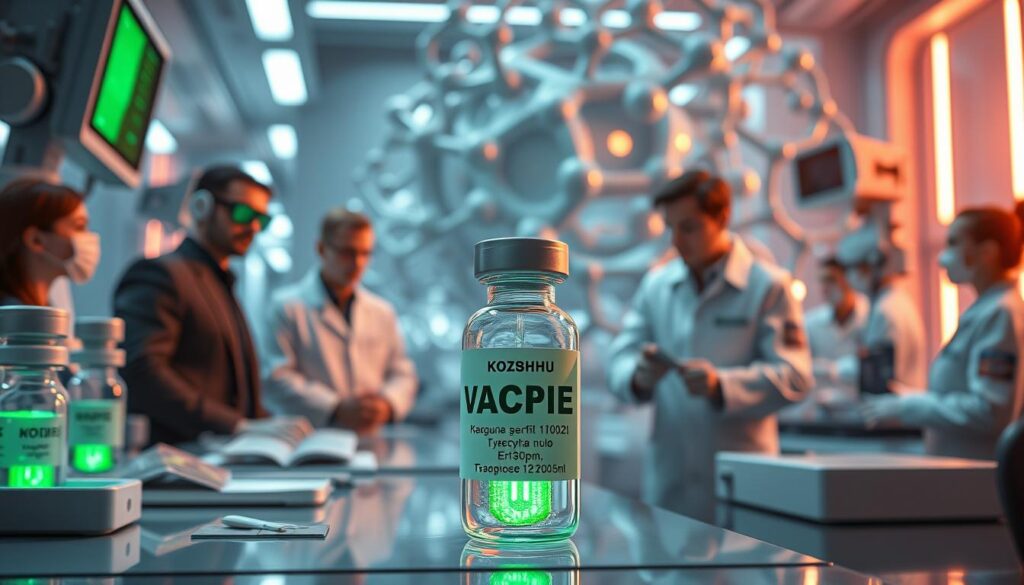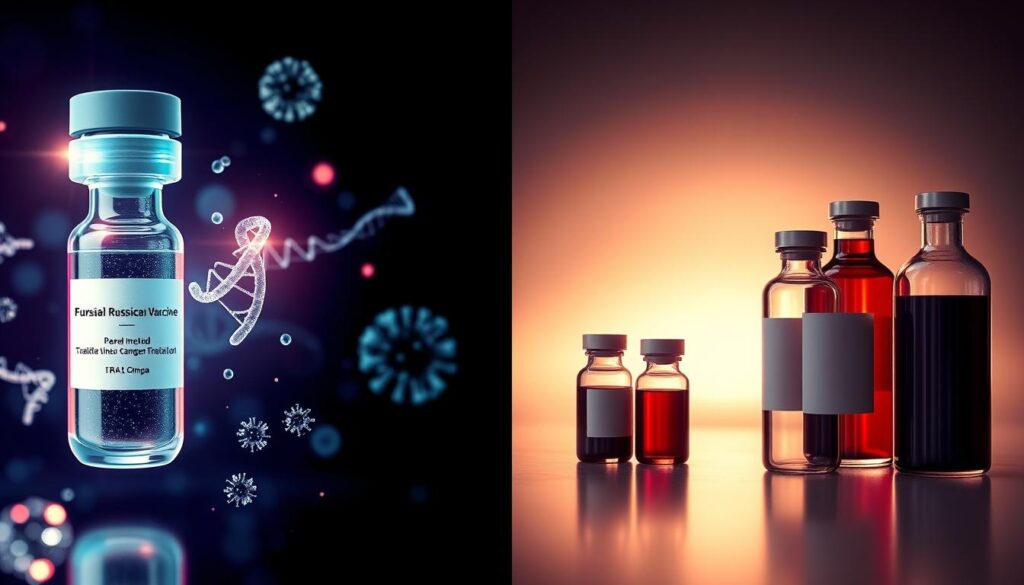The Russian cancer vaccine is making waves in cancer treatment. It’s a big step forward in fighting cancer. This vaccine is part of a growing field called cancer immunotherapy.
This vaccine shows how far cancer research has come. It’s a sign of the progress we’re making. It’s also a beacon of hope for those fighting cancer.
Key Takeaways
- The Russian cancer vaccine is a form of cancer immunotherapy
- It has shown promise as a potential breakthrough treatment for various types of cancer
- Cancer immunotherapy is a growing field of research
- The Russian cancer vaccine is a notable example of advancements in cancer research
- Continued investment in cancer research is crucial for future breakthroughs
- The Russian cancer vaccine has significant implications for the future of cancer treatment
Understanding the Breakthrough in Russian Cancer Treatment
Recent Russian medical research has led to big steps in fighting cancer. This breakthrough uses new ways to boost the body’s defenses. It helps target and get rid of cancer cells better than old treatments.
Definition of Cancer Immunotherapy
Cancer immunotherapy uses the body’s immune system to fight cancer. It makes the immune system stronger. This way, it can find and kill cancer cells more effectively than before.
Historical Context of Cancer Vaccines
The vaccine history against cancer goes back many years. Early work focused on stopping virus-related cancers. Now, research aims to treat existing cancers by targeting specific tumor antigens.
Significance of the Russian Development
The newest Russian medical research has brought a new cancer vaccine. It builds on past studies. This breakthrough not only moves cancer immunotherapy forward. It also gives patients new hope with better treatment results and easier access.
| Aspect | Traditional Therapies | Russian Cancer Vaccine |
|---|---|---|
| Mechanism | Targets and destroys rapidly dividing cells | Enhances immune system to specific cancer cells |
| Side Effects | Often severe and widespread | Potentially fewer and milder side effects |
| Effectiveness | Varies widely among patients | Aims for higher consistency in treatment outcomes |
The Science Behind Russian Cancer Vaccine Development
The Russian cancer vaccine uses a smart cancer vaccine mechanism to boost the body’s defenses. It gets the immune system response ready to fight cancer cells well.
This vaccine is great at tumor-targeting. It makes sure immune cells only go after cancer cells, not healthy ones. Russian scientists use top-notch biomolecular techniques for this precise targeting.
- Antigen Presentation: The vaccine introduces cancer-specific antigens to the immune system.
- T Cell Activation: Immune cells are activated to seek out and destroy cancer cells.
- Memory Formation: Long-lasting immunity is developed to prevent cancer recurrence.
This vaccine combines old-school immunotherapy with new genetic engineering. It makes a strong and flexible treatment. This mix not only boosts the immune system response but also keeps working well against different cancers.
| Component | Function | Benefit |
|---|---|---|
| Antigens | Trigger immune response | Enhanced recognition of cancer cells |
| Adjuvants | Boost immune activation | Stronger and longer-lasting immunity |
| Delivery System | Targets vaccine to tumor sites | Increased precision in tumor-targeting |
Key Components and Mechanism of Action
The Russian cancer vaccine has several key parts to fight and kill cancer cells. Knowing these parts helps us understand how it works.
Active Ingredients
The vaccine has tumor-associated antigens that find cancer cells. These antigens work with adjuvants to boost the immune system. This makes the body attack cancer cells better.
Delivery System
The vaccine uses nanoparticles to get to the tumor. This method makes the vaccine work better and reduces side effects. It ensures the vaccine reaches the right place.
Immune Response Activation
Dendritic cells are activated to present tumor antigens to T-cells. This starts a strong immune response. It helps the body find and kill cancer cells.
Development Timeline and Research Phases
The Russian cancer vaccine’s journey has seen a lot of research progress. It went through careful planning in different vaccine development stages. First, scientists studied cancer cells to find the best treatment.
Then, the vaccine moved to clinical trials. Here, it was tested for safety and how well it worked. Here’s a quick look at the main stages:
| Phase | Description | Key Milestones |
|---|---|---|
| Phase I | Initial safety testing on a small group of volunteers. | Established dosage ranges and identified side effects. |
| Phase II | Expanded testing to assess efficacy and side effects. | Demonstrated preliminary effectiveness in cancer patients. |
| Phase III | Large-scale trials to confirm effectiveness and monitor adverse reactions. | Validated the vaccine’s benefits and safety profile. |
Finishing these phases shows the vaccine’s strong research progress. It could be a big help in fighting cancer.
Clinical Trial Results and Effectiveness
The Russian cancer vaccine has been tested thoroughly. It has shown good safety and early signs of working well. Clinical trial results from Phase I are promising.
Phase I Outcomes
Phase I trials looked at safety and how well the vaccine was tolerated. People who took the vaccine had few side effects. The early efficacy data showed a strong immune response in many patients.
Phase II Data Analysis
In Phase II, the vaccine was tested on different types of cancer. The results showed better patient outcomes. Tumors shrunk and survival times got longer for some patients. This shows the vaccine’s potential to help many people.
Current Trial Status
Now, trials are including more people and different cancers. Scientists are watching how the vaccine works over time. They are also making the vaccine better to help even more people.
| Phase | Participants | Key Findings | Status |
|---|---|---|---|
| Phase I | 50 | Confirmed safety; observed immune response in 70% of patients | Completed |
| Phase II | 200 | Improved survival rates by 20% in treated groups | Completed |
| Phase III | 500 | Ongoing studies on long-term efficacy and broader applications | In Progress |
Comparing Russian Cancer Vaccine with Existing Treatments
The Russian cancer vaccine brings a new way to fight cancer. It’s different from old treatments like chemotherapy and radiation. These methods harm all fast-growing cells, not just cancer ones. The vaccine, on the other hand, boosts the body’s immune system to attack cancer cells.
Here are some main differences:
- Targeted Action: The vaccine goes after cancer cells only, leaving healthy cells alone.
- Side Effect Profile: People getting the vaccine often face fewer and milder side effects than with other treatments.
- Long-Term Efficacy: Early research shows the vaccine might help prevent cancer from coming back for a longer time.
This vaccine is seen as a hopeful addition to cancer treatments. While chemotherapy and radiation are still key, the vaccine offers a new option. It can be used by itself or with other treatments, aiming to better patient results.
Doctors think adding this vaccine to standard treatments could change cancer care. It could lead to more tailored and effective ways to fight the disease.
Safety Profile and Side Effects
Ensuring vaccine safety is key in making new cancer treatments. A lot of testing has been done to find any side effects of the Russian cancer vaccine.
Documented Adverse Reactions
During clinical trials, several side effects were watched. Common ones include mild fever, tiredness, and pain at the injection site. These usually go away on their own and don’t last long.
Long-term Safety Considerations
Long-term health impacts are being checked in ongoing studies. So far, the vaccine doesn’t seem to have big long-term risks. But, it’s important to keep watching to make sure it stays safe.
| Side Effect | Frequency |
|---|---|
| Mild Fever | 15% |
| Fatigue | 10% |
| Injection Site Pain | 25% |
| Headache | 8% |
Target Cancer Types and Applications
The Russian cancer vaccine targets many cancer types. It’s a key player in fighting lung, breast, and colorectal cancers, and more.
This vaccine shines in its ability to work at all cancer stages. It’s effective whether you’re in the early stages or dealing with advanced cancer. It offers personalized treatment applications to boost its power.
Personalized medicine is at the heart of this vaccine’s approach. It looks at a patient’s genes to create a vaccine that attacks specific cancer cells. This makes treatment more effective and cuts down on side effects.
Here are the main treatment applications of the Russian cancer vaccine:
- Boosts the immune system to fight cancer cells.
- Shrinks tumors in affected areas.
- Helps prevent cancer from coming back in high-risk patients.
Below is a table showing the cancer types targeted and their treatment applications:
| Cancer Type | Treatment Application | Personalized Medicine Approach |
|---|---|---|
| Lung Cancer | Reduces tumor size and stops it from spreading | Genetic profiling to target specific mutations |
| Breast Cancer | Prevents cancer from coming back or spreading | Custom vaccine based on hormone receptor status |
| Colorectal Cancer | Boosts immune response against cancer cells | Personalized antigens based on patient’s tumor |
| Melanoma | Targets and eliminates melanoma cells | Tailored vaccine components for specific skin cancer markers |
Regulatory Approval Process and Status
The Russian cancer vaccine’s path to market is complex. It must pass a detailed drug approval process. Meeting regulatory standards is key for acceptance at home and abroad.
Russian Health Authority Standards
In Russia, the State Expert Center for Drugs and Bioresources handles drug approvals. They check if the vaccine meets strict criteria. This includes looking at clinical trial results and safety data.
Following these rules makes sure the vaccine works well and is safe for people to use.
International Regulatory Requirements
To sell the vaccine worldwide, it must also meet global standards. This means following rules from the World Health Organization (WHO) and the European Medicines Agency (EMA). It needs more clinical trials and paperwork to fit different rules.
Getting approval from international bodies helps the vaccine reach more places. Working with global health groups makes it easier to get the vaccine to different markets quickly.
| Regulatory Phase | Russia | International |
|---|---|---|
| Submission | State Expert Center | WHO/EMA |
| Clinical Trials | Phase I-III | Additional Phase IV |
| Approval | Federal Service | Respective Agencies |
Global Collaboration and Research Partnerships
Creating the Russian cancer vaccine is a team effort from around the world. It’s thanks to international cooperation. Researchers from Russia team up with the best places globally. This mix of skills helps improve the vaccine.
The key to success is scientific collaboration. Scientists share discoveries and solve problems together. This teamwork speeds up the research and makes the vaccine better.
- Partnerships with European research centers
- Joint studies with North American universities
- Collaborative projects with Asian biotechnology firms
These research networks help share data and tools. This makes the vaccine’s development faster and more complete. The work of teams worldwide leads to a strong and effective vaccine.
Thanks to international cooperation, the project moves forward. It also shows the power of unity in science. It proves we can tackle big health issues together.
Cost Implications and Accessibility
The cost of the Russian cancer vaccine is key to its success. It affects both the producers and the patients. Knowing these treatment costs is crucial.
Production Expenses
Creating the vaccine is expensive. It includes research, quality checks, and getting it to people. These costs affect the price, making it important to keep it affordable.
Patient Cost Considerations
For those getting the vaccine, the cost can be a big issue. Programs and government help are being looked into. They aim to make the vaccine more accessible, so more people can get it without financial worries.
Insurance Coverage Potential
Getting the vaccine covered by insurance is important for its use. Insurance companies, both public and private, are checking if it’s worth covering. This will greatly affect how many people can get the vaccine.
| Cost Aspect | Description | Impact on Accessibility |
|---|---|---|
| Production Expenses | Includes research, manufacturing, and distribution costs. | Higher costs may increase the final price, affecting affordability. |
| Patient Costs | Out-of-pocket expenses for individuals receiving the vaccine. | Financial assistance programs can reduce the burden, enhancing access. |
| Insurance Coverage | Extent to which insurance plans cover the vaccine. | Comprehensive coverage increases patient accessibility and uptake. |
Implementation Challenges and Solutions
Introducing the Russian cancer vaccine on a large scale faces many hurdles. One big challenge is the healthcare infrastructure. Many areas lack the facilities needed to store and give the vaccine right.
Another problem is treatment adoption. Doctors might be slow to adopt new treatments without solid proof they work and are safe.
Also, there’s a big need for medical training. Doctors need to know how to use the new vaccine right. This ensures it’s given correctly and well.
To beat these challenges, we must invest in healthcare. We need to upgrade facilities and make sure the vaccine is stored right. This helps the vaccine get to where it’s needed smoothly.
Also, we should work on making doctors and nurses more aware. We can do this with campaigns and showing them strong evidence from trials. This builds trust with both doctors and patients.
Improving medical training programs is key. This way, doctors will know how to use the vaccine right. Working with global health groups can also bring in more help and knowledge to solve these problems.
| Challenge | Solution |
|---|---|
| Healthcare Infrastructure | Upgrade facilities and ensure proper storage |
| Treatment Adoption | Conduct awareness campaigns and present clinical data |
| Medical Training | Enhance training programs and collaborate with experts |
Future Research Directions and Potential Improvements
Research on Russian cancer vaccines is moving forward fast. This work is making treatments better. It’s all about improving what we have and finding new ways to use it.
Ongoing Studies
Right now, scientists are working hard to make treatments even better. They want to make the vaccine work for more types of cancer. This is key to unlocking the vaccine’s full power in fighting cancer.
Planned Enhancements
Next steps include making the vaccine stronger and finding better ways to give it to patients. They’re also looking into mixing the vaccine with other treatments. This could lead to even better results for patients.
| Future Developments | Research Pipeline | Treatment Optimization |
|---|---|---|
| Enhanced Vaccine Formulation | Expanding Clinical Trials | Combination Therapies |
| Innovative Delivery Methods | Long-term Efficacy Studies | Personalized Treatment Plans |
| Biomarker Identification | Global Research Collaborations | Dosage Optimization |
Conclusion
The Russian cancer vaccine is a big step forward in fighting cancer. It shows great promise for changing how we treat cancer. This could lead to new treatments for people all over the world.
This vaccine works in a special way and has shown great results in tests. It could help people live longer and feel better while fighting cancer. The work of scientists from different countries has been key in making this vaccine a reality.
To make the most of this vaccine, we need to keep funding research and working together. This will help us overcome the challenges we face. With new ideas and teamwork, the future of cancer treatment looks bright.
Even though there are obstacles, the progress we’ve made is important. It shows the power of never giving up and working together. The Russian cancer vaccine is proof of what can happen when we focus on finding new ways to fight cancer.
As we move forward, using this vaccine in everyday treatment could change cancer care. It could lead to treatments that are more tailored to each person’s needs. The work to improve cancer treatment will keep going, driven by our goal to help patients and push medical science forward.


